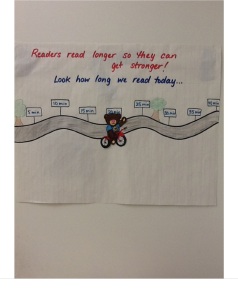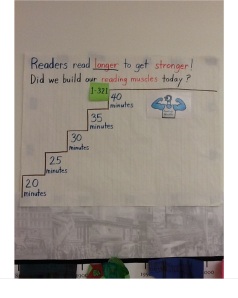Charting Celebrates Effort
Posted: March 10, 2013 Filed under: Uncategorized | Tags: effort, goals, stamina, volume 1 CommentIn the sports world this month may be referred to as March Madness, but in the world of schools it is March Marvels. March is a marvelous month for children and teachers alike because this is the time of year we traditionally see great spurts of growth in our children, both physically and academically. They are taller, speak more eloquently, and can read, write and compute at new levels of achievement. And teachers can marvel that all their efforts are paying off. With this in mind we thought we would share some charts that celebrate effort and expectations as we head forward towards Spring.
For most teachers increasing children’s reading stamina is an ongoing goal because of its importance in strengthening their reading abilities and fluency. In fact it is often something that was fussed over quite a bit at the beginning of the year as routines and expectations for reading workshop time were set up. We saw many a stamina reading chart hanging up in classrooms during these beginning months of school. But, as with most charts from the beginning of the year they were replaced by more current charts that focused on critical reading strategies and skills. But as students are preparing to read more difficult and varied texts the issue of stamina is one worth revisiting. Making a chart that records the increasing time spent reading (or writing) announces to the world that this is something important and increasing the time reading books is worth striving towards as a class.
Below we show some examples of charts that celebrate the effort being put forth by classrooms to increase their time reading books. Again, the message being put forth is that this is something important and that together we can accomplish great things and we thank the amazing teachers, Jung Choe, first grade, and CTT team Sarah Carolan and Lindsay Brickell, at PS 59 for sharing these with us.
This first chart shows a delightful bear on a bicycle riding on a meandering path. The markers show the times achieved, the current reading times, and the times the class hopes to reach. This chart did not just arrive one day because it was cute and fun. This CTT/Inclusion class spent time talking about their reading, how long they used to read for, how long they can now read for, and what it was like to keep reading even when they got tired or distracted. Together they decided to try to increase their time reading like they try to ride for longer times on their bicycles in the park.
In another first grade classroom the teacher used a favorite character, Pigeon from the Mo Willems series, to pump up her children’s enthusiasm for the challenge ahead – to read longer without stopping. Again, the goals were developed with the children and they took turns keeping track of their reading stamina. This is a chart that is referred to often and steps moved up when the class is able to maintain the increased time consistently for the week. In other words, this is not something we do once, give a shout out, and call it a day. This is something that will take time to become a habit, to reach a goal. It requires effort.
Kristi also found a need to increase reading stamina among her students, so she created with her class of Kinders a plan that increases stamina by reading in increasing increments of time by including independent reading, partner reading, and library reading time. By providing varied opportunities to read in various situations, the children are encouraged to keep reading for increasingly longer periods of time. Again, the more children read, the longer they read for, and this increases their ability to read successfully and well. It also allows the teacher increased time to confer and teach small groups.

This chart reminds children of their intermediary goals as they continue to read during reading workshop.
These are but a few examples of how teachers are setting challenges and celebrating effort in order to help their students, not only set goals, but develop agency and a ‘can do’ attitude that will be a life skill that each and every child can carry with them throughout their life. Let us know what other ways you are sparking your students to increase effort and drive to accomplish set goals.
Until next time, happy charting!
Marjorie & Kristi



